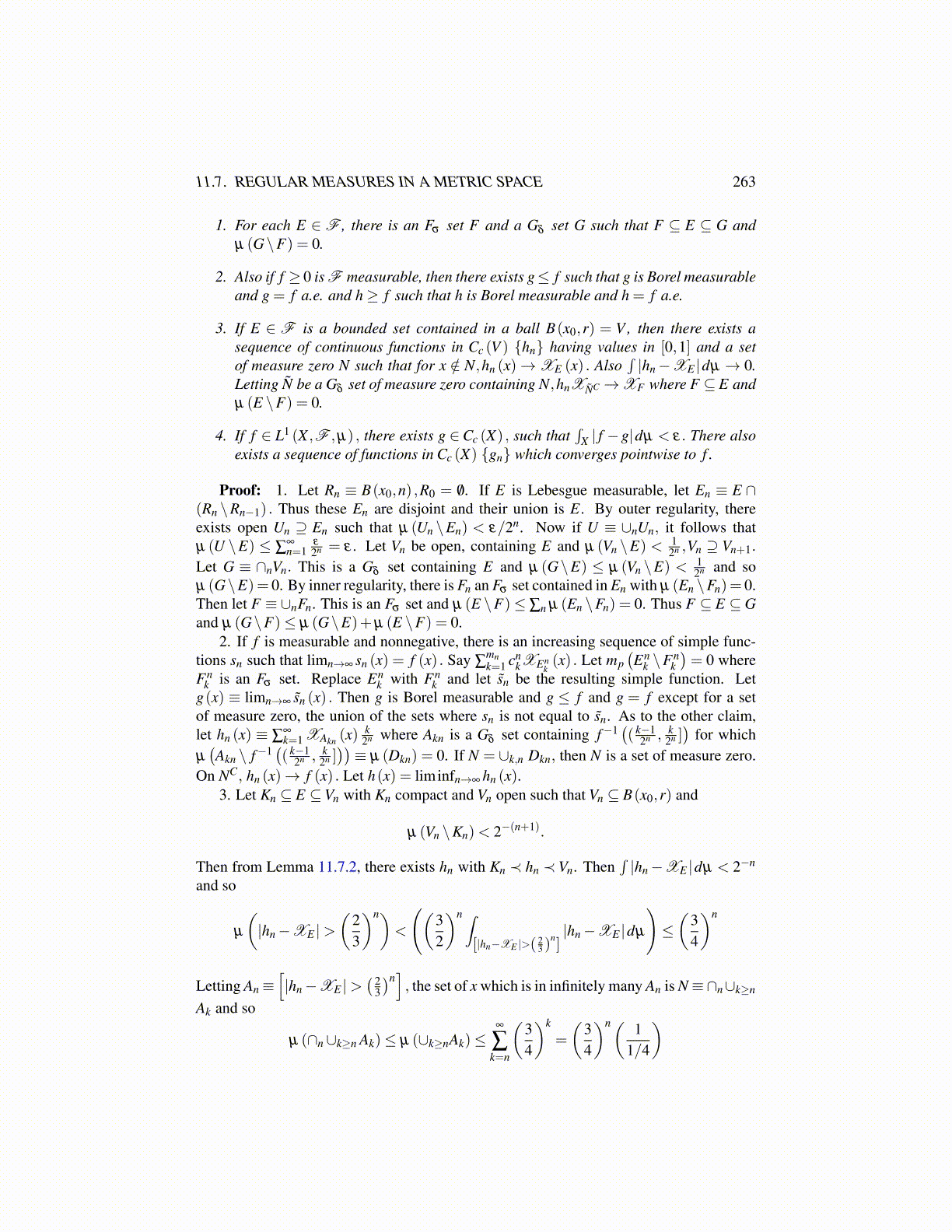
11.7. REGULAR MEASURES IN A METRIC SPACE 263
1. For each E ∈ F , there is an Fσ set F and a Gδ set G such that F ⊆ E ⊆ G andµ (G\F) = 0.
2. Also if f ≥ 0 is F measurable, then there exists g≤ f such that g is Borel measurableand g = f a.e. and h≥ f such that h is Borel measurable and h = f a.e.
3. If E ∈ F is a bounded set contained in a ball B(x0,r) = V , then there exists asequence of continuous functions in Cc (V ) {hn} having values in [0,1] and a setof measure zero N such that for x /∈ N,hn (x)→XE (x) . Also
∫|hn−XE |dµ → 0.
Letting Ñ be a Gδ set of measure zero containing N,hnXÑC →XF where F ⊆ E andµ (E \F) = 0.
4. If f ∈ L1 (X ,F ,µ) , there exists g ∈Cc (X) , such that∫
X | f −g|dµ < ε. There alsoexists a sequence of functions in Cc (X) {gn} which converges pointwise to f .
Proof: 1. Let Rn ≡ B(x0,n) ,R0 = /0. If E is Lebesgue measurable, let En ≡ E ∩(Rn \Rn−1) . Thus these En are disjoint and their union is E. By outer regularity, thereexists open Un ⊇ En such that µ (Un \En) < ε/2n. Now if U ≡ ∪nUn, it follows thatµ (U \E) ≤ ∑
∞n=1
ε
2n = ε . Let Vn be open, containing E and µ (Vn \E) < 12n ,Vn ⊇ Vn+1.
Let G ≡ ∩nVn. This is a Gδ set containing E and µ (G\E) ≤ µ (Vn \E) < 12n and so
µ (G\E)= 0. By inner regularity, there is Fn an Fσ set contained in En with µ (En \Fn)= 0.Then let F ≡ ∪nFn. This is an Fσ set and µ (E \F)≤ ∑n µ (En \Fn) = 0. Thus F ⊆ E ⊆ Gand µ (G\F)≤ µ (G\E)+µ (E \F) = 0.
2. If f is measurable and nonnegative, there is an increasing sequence of simple func-tions sn such that limn→∞ sn (x) = f (x) . Say ∑
mnk=1 cn
kXEnk(x) . Let mp
(En
k \Fnk
)= 0 where
Fnk is an Fσ set. Replace En
k with Fnk and let s̃n be the resulting simple function. Let
g(x) ≡ limn→∞ s̃n (x) . Then g is Borel measurable and g ≤ f and g = f except for a setof measure zero, the union of the sets where sn is not equal to s̃n. As to the other claim,let hn (x) ≡ ∑
∞k=1 XAkn (x)
k2n where Akn is a Gδ set containing f−1
(( k−1
2n , k2n ])
for whichµ(Akn \ f−1
(( k−1
2n , k2n ]))≡ µ (Dkn) = 0. If N = ∪k,n Dkn, then N is a set of measure zero.
On NC, hn (x)→ f (x) . Let h(x) = liminfn→∞ hn (x).3. Let Kn ⊆ E ⊆Vn with Kn compact and Vn open such that Vn ⊆ B(x0,r) and
µ (Vn \Kn)< 2−(n+1).
Then from Lemma 11.7.2, there exists hn with Kn ≺ hn ≺ Vn. Then∫|hn−XE |dµ < 2−n
and so
µ
(|hn−XE |>
(23
)n)<
((32
)n ∫[|hn−XE |>( 2
3 )n]|hn−XE |dµ
)≤(
34
)n
Letting An≡[|hn−XE |>
( 23
)n], the set of x which is in infinitely many An is N≡∩n∪k≥n
Ak and so
µ (∩n∪k≥n Ak)≤ µ (∪k≥nAk)≤∞
∑k=n
(34
)k
=
(34
)n( 11/4
)